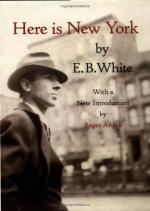
|
| Name: _________________________ | Period: ___________________ |
This test consists of 15 multiple choice questions and 5 short answer questions.
Multiple Choice Questions
1. What was White's main mode of transportation when he lived in the city?
(a) Walking.
(b) Busses.
(c) The train.
(d) The subway.
2. Where did White live for a while when he was poor in New York?
(a) Grand Central Terminal.
(b) Broadway theaters.
(c) A bus station.
(d) Central Park.
3. What does White say would happen if the communities in New York stopped working together for one day?
(a) The nation would never be the same.
(b) A war would be waged.
(c) It would explode.
(d) The population would decrease.
4. When was the Empire State Building erected?
(a) During WWI.
(b) During the Vietnam War.
(c) During WWII.
(d) During the depression.
5. How does White say you can spot the people who are disappointed in the city?
(a) They will be taking too many pictures.
(b) They will be packing their bags.
(c) They will seem angry about nothing.
(d) They will be eating quietly.
6. Which of these cities does White say gives the same sense to all its citizens?
(a) None of the answers is correct.
(b) Detroit.
(c) Paris.
(d) London.
7. What does White say a small number of visitors will feel about their visit to New York?
(a) They will hate it.
(b) They will be overwhelmed.
(c) They will love it.
(d) They will be disappointed.
8. What does White remember the policemen of his youth always having on hand?
(a) Guns.
(b) Clubs.
(c) Nightsticks.
(d) Nothing.
9. What does White try to have a balance of in this book?
(a) True and false ideals.
(b) Current and past information.
(c) Facts and embellishments.
(d) Good and bad comments.
10. What does White give the numbers of?
(a) The populations of different nationalities.
(b) The overall population over the last 10 years.
(c) The number of runs for the transit system.
(d) The populations in different communities.
11. What does White compare a non-local visiting New Yorker to?
(a) An alien visiting a new world.
(b) A commoner coming to a royal court.
(c) A foreigner coming to a new country.
(d) A fish talking to a bird.
12. What amazes White about New York?
(a) That there are other places like it.
(b) That so many people love it.
(c) That is has quiet moments.
(d) That it sustains itself.
13. What does White think should have destroyed it years ago?
(a) The pollution.
(b) The panic.
(c) The animals.
(d) The population.
14. What were pulled down in New York since White was a boy?
(a) Old buildings.
(b) Elevated railways.
(c) Park playgrounds.
(d) Fishing docks.
15. What parts of the city does White say has changed the most?
(a) The higher parts.
(b) The bad parts.
(c) The good parts.
(d) The lower parts.
Short Answer Questions
1. Why does White feel distant from New York?
2. What does White say the city gives a sense of to all people?
3. What does White say an enemy could use to destroy the city?
4. What has been gradually removed from the city since White lived there?
5. What does White use as a reference to write this book?
|
This section contains 507 words (approx. 2 pages at 300 words per page) |

|




